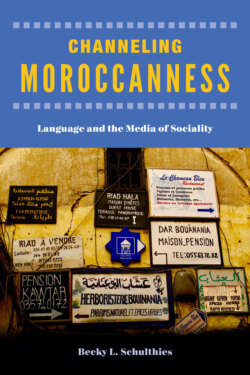Читать книгу Channeling Moroccanness - Becky L. Schulthies - Страница 6
Note on Transcription and Translation
ОглавлениеI owe a great debt to my many Fassi colleagues and friends for allowing me to record, assisting me with transcription, and clarifying my understanding of many hours of recordings and observations. I based the transliterations in this text on my understanding of Moroccan ways of speaking, using the International Journal of Middle East Studies (IJMES) transliteration key. However, the transcriptions are my Moroccan contributors’ understandings of how to write Moroccan spoken and written forms, and as Chapter 4 of this book points out, orthographic heterogeneity was common in everyday Fassi practices of writing their ways of speaking. So don’t be surprised if you find variability in the transcriptions—it reflects the writing practices of the Fassis I wrote about in this ethnography.
An Arab student of mine pointed out that the use of the term “Modern Standard Arabic” (MSA) vs. alfuṣḥā was an educational shibboleth; it demonstrated what kind of Arabic training one had. Instead of using my own terms, I opted throughout this book to use Fassi terms for the main language forms I analyzed: l‘arabīya (Arabic) often contrasted with français (French), darīja (Moroccan Arabic) often contrasted with fuṣḥā (formal “literary” Arabic). But these were not fixed registers: they were classifications that did important social work, as you will soon read.
| Arabic Letters | IJMES Transliteration | Phonetic Value (IPA) | ||
|---|---|---|---|---|
| ﺀ | ’ | [Ɂ] | ||
| ﺍ | ā | [æː] | ||
| ﺏ | b | [b] | ||
| ﺕ | t | [t] | ||
| ﺙ | th | [θ] | ||
| ﺝ | j / g / ǧ | [ʒ] / [ʤ] / [g] | ||
| ﺡ | ḥ H | [ħ] [˙] | ||
| ﺥ | kh / x | [X] | ||
| ﺩ | d | [d] | ||
| ﺫ | dh | [D] | ||
| ﺭ | r | [r] | ||
| ﺯ | z | [z] | ||
| ﺱ | s | [s] | ||
| ﺵ | sh / š | [ʃ] | ||
| ﺹ | ṣ | [ṣ] [s≥] | ||
| ﺽ | ḍ | [ḍ] [d≥] | ||
| ﻁ | ṭ | [ṭ] [t≥] | ||
| ﻅ | ẓ | [ð] [D≥] | ||
| ﻉ | ‘ ʿ / ‘ | [ʕ] | ||
| ﻍ | gh / g˙ | [ɣ] | ||
| ﻑ | f | [f] | ||
| ﻕ | q / ḳ | [q] | ||
| ﻙ | k | [k] | ||
| ﻝ | l | [l] | ||
| ﻡ | m | [m] | ||
| ﻥ | n | [n] | ||
| ﻩ | h | [h] | ||
| ﻭ | w / u: | [w] / [u:] | ||
| ﻱ | y / i: | [j] / [i:] |
